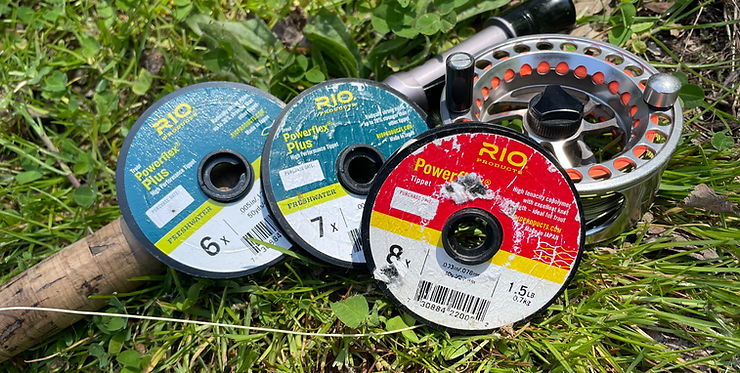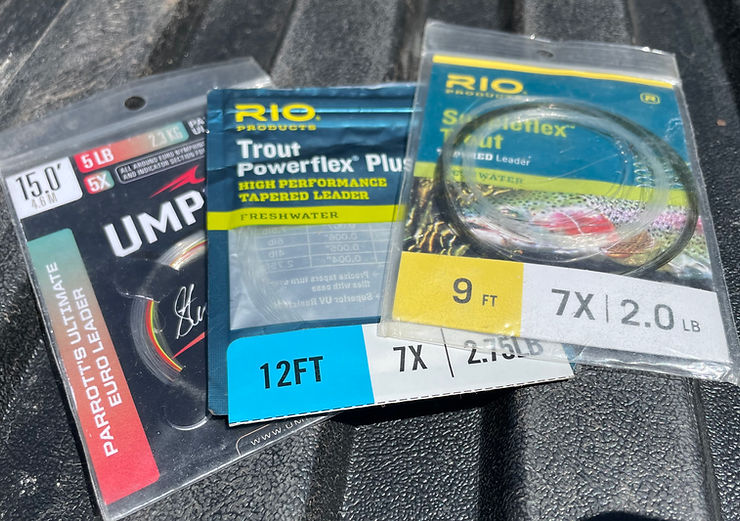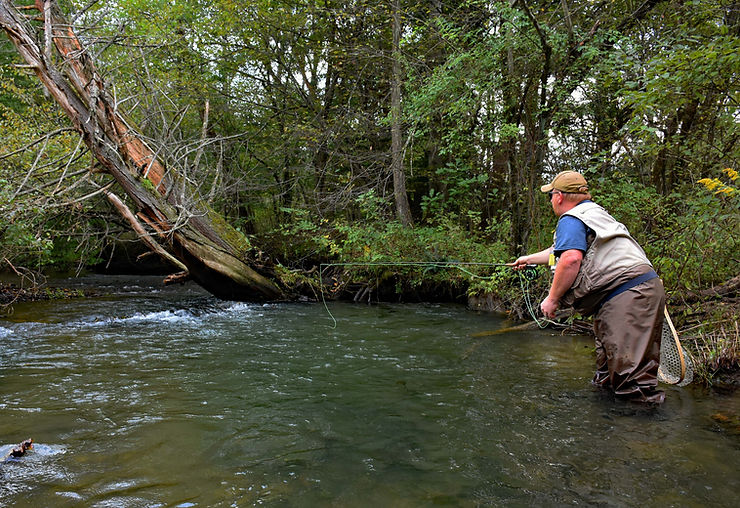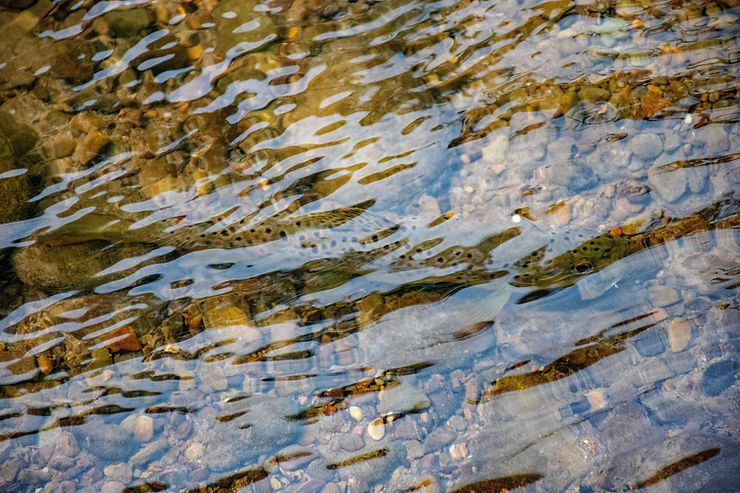6 Tips for Fishing Low, Clear Water

Many streams across the country have been running at historically low levels the past two years, and with lower water comes certain challenges. Low, clear water can make trout more selective, spooky, and harder to approach, but not impossible to catch. Here are six tactics I use to continue catching trout in these types of conditions.
1. Downsize your gear.
Also, the smaller diameter of 7x as opposed to 5x can be substantial in the world of trout. The smaller diameter casts a similarly smaller shadow.

Fishing with a 7x or even 8x tippet requires a few adjustments, though. If using a fast-action rod, you may experience a few more break-offs simply because the stiffer rod is less forgiving. These rods are great for indicator nymphing or using streamers, but a medium- or slow-action rod will handle lighter tippets much better.
Downsizing the size or weight of your fly rod isn’t necessary. I often read articles about using a 2- or 3-weight rod during low and clear conditions, but that’s not always good advice. Using rods that light means you’ll inevitably have to play fish longer to land them (see the end of this post about why that isn’t recommended). Rather, I stick with the same 4-, 5-, and 6-weight rods that I fish with all year and instead downsize my other gear.
2. Longer leaders and tippets
Lengthening leaders and tippets can help you be more successful, too. The more distance you create between the fly and the end of the fly line is very beneficial when water is low and clear, especially on heavily-pressure streams or sections designated Delayed Harvest Artificial Lures Only and Catch and Release. The heavy shadow cast by the fly line can send spooky fish darting for cover quicker than anything. Also, the heavier fly line can cause more disturbance when it hits the water. Longer leaders and tippets help reduce the impact this has on trout.

3. Short, accurate casts
In my experience, unless you’re a gold medal fly caster, long casts almost always spook more trout than short, accurate casts. But this is the tendency of almost every fly fisher I observe – including myself! We always think there are more fish farther away from us than there are near to our position. Or we assume we’ve spooked the fish closest to us and instead cast to those farther away that may not be spooked. But this isn’t always the case.
The majority of the time, you’re better off trying to wade closer to the trout you intend to cast to. Move slowly, keep low, and try to get into position before even making your first cast. Also, once in position, just wait and observe the stream for a few moments. Sometimes you can pick up on little nuances that can help you target certain fish – such as exactly where to cast in order to hit the seam where that fish is feeding. This is a big one because the first cast or two are typically the most important. If trout are skittish, they’ll rarely give you more opportunities than that in low, clear water.
Waiting a minute or two before casting can also help trout become accustomed to your presence. Don’t be surprised if even spooked trout return to their positions and resume feeding after a few minutes. Whatever you do, don’t cast to spooked fish. You have basically zero chance of getting them to eat once spooked. In this case, you’re better off trying a different pool and coming back to them once they’ve settled down again.

As water levels drop and become ultra-clear, my fly selection changes. I use more nymphs that are drab and natural in appearance and fewer beadhead nymphs or anything with much sparkle. Basic attractor nymphs such as Pheasant Tails and Walts Worms are great patterns this time of year.
Also, if you’re not getting a lot of action, try dropping down one or two sizes. Instead of a size 14, tie on a size 18 or size 20 instead. This is my rule-of-thumb for fishing any time of year: if I know my fly selection is right but I’m not catching as many fish as I think I should, I’ll drop down a couple sizes before changing patterns completely.
5. Stealth and patience
Use a low and slow approach when walking up to pools. Wear neutral-colored clothing or clothes that match the surroundings. Also be careful with how your shadow falls on the water. Approach from downstream, behind the trout, and stay out of their field of view while casting. If I am using a dry fly, I will make my false casts to the side until I have the distance measured, and then my final cast will land the fly where it needs to be in front of the fish.
To avoid lining trout, use a reach cast. As the fly line shoots forward, perform an exaggerated movement with your rod that throws the line to the left or right rather than directly over the trout’s feeding lie. This will ensure that the fly passes over the fish before the line.

6. Types of water to focus on
In short, riffles and structure are prime lies for feeding fish in low, clear water. Trout sitting out in the open in slow-moving pools are typically not feeding anyway, or they don’t last long because they get picked off by avian predators.
Trout can survive in some pretty skinny water. Basically, if the water is deep enough to cover their backs, they can live and feed there, but it has to be moving enough to create a broken surface. This broken surface is itself a type of structure that provides security for trout. So when water levels get really low, target areas where you can’t clearly see the stream bottom.
In deeper, clearer water, I target the structure. Don’t be afraid to bang your nymphs up against rocks and logs or under brush, even if it means occasionally losing a fly. This is where the trout will be, hugging tight to the structure, waiting to pounce on anything that comes close.
A Word Regarding Water Temperature
Later in the season (late spring/early summer here in the northeast), with low and clear water often comes higher water temperatures. It is the responsibility of each individual angler to know when and when not to fish. Once water temperatures surpass 68 degrees F, trout can get stressed easily and have a hard time recovering from the catch, even with proper catch handling. Larger fish are especially prone to death. Sure, they may swim away and re-take their position in the current, but that doesn’t mean they’ll survive 12 or 24 hours later. Sometimes, the impact of the catch doesn’t take effect until hours later.
A few things you can do to increase survival rates:
1. Fish only in the early morning, when water temperatures are coolest.
2. Land and release as quickly as possible – the longer a fish fights, the more lactic acid builds up in its system, which reduces its chances of survival, not to mention needlessly exhausts the fish.
3. Release the fish into clear, clean water out in the current and NOT water that is muddy or silty.
4. Don’t fish at all if the water is above 70 degrees F.
5. If you really want to go fishing and can’t abide by any of these guidelines, focus on stocked put-and-take waters that warm up too much during the summer for trout survival. And instead of catching and releasing all day, only fish until you catch your daily creel limit of trout and treat yourself and your family to a tasty fish fry.
Did You Find These Clear Water Fishing Tips To Be Useful?
Stay up to date with the Dark Skies Fly Fishing monthly newsletter for free and receive the latest posts in fly fishing news, tricks, tips, and techniques, stream reports, as well as updates on new flies added to the Online Store and exclusive discounts!
Sign Up Now